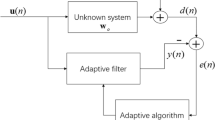Abstract
In this paper, two methods for estimating the efficiency of the multichannel reception of a noisy signal have been compared. The first method is based on sliding optimum estimates of both covariance matrices and response vectors of a useful signal in receiving channels. The second method is based on adaptive noise filtering according to the Widrow–Hoff stochastic gradient descent algorithm. The second method is only shown to provide the maximum reception efficiency if there is no useful signal in additional receiving channels.
Similar content being viewed by others
References
Gerasimenko, V.G., Lavrukhin, Yu.N., and Tukota, V.I., Metody zashchity akusticheskoi rechevoi informatsii ot utechki po tekhnicheskim kanalam (Methods for Protection of the Acoustic Speech Information from Leakage via Technical Channels), Moscow: RTsIB Fakel, 2008.
Baranov, A.P., On the possibility of the use of signal filtering to assess the Mahalanobis distance, Probl. Inf. Bezop., Komp. Sist., 2013, no. 3, pp. 55–61.
Tsypkin, Ya.Z., Osnovy teorii obuchayushchikhsya sistem (Fundamentals of the Theory of Learning Systems), Moscow: Nauka, 1970.
Ivchenko, G.I. and Medvedev, Yu.I., Vvedenie v matematicheskuyu statistiku (Introduction to Mathematical Statistics), Moscow: LKI, 2010.
Widrow, B., Adaptive noise cancelling: Principles and applications, IEEE, 1975, vol. 63, no. 12, pp. 69–98.
Baranov, A.P., The convergence of a class of stochastic approximation procedures, Kibernetika, 1987, no. 4, pp. 64–69.
Rao, S.R., Lineinye statisticheskie metody i ikh primenenie (Linear Statistical Methods and Their Application), Moscow: Nauka, 1968.
Author information
Authors and Affiliations
Corresponding author
Additional information
Original Russian Text © A.P. Baranov, 2015, published in Problemy Informatsionnoi Bezopasnosti. Komp’yuternye Sistemy.
About this article
Cite this article
Baranov, A.P. Efficiency comparison of optimum and adaptive methods for multichannel signal filtering. Aut. Control Comp. Sci. 49, 615–621 (2015). https://doi.org/10.3103/S0146411615080210
Received:
Published:
Issue Date:
DOI: https://doi.org/10.3103/S0146411615080210




